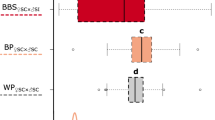Abstract
Whenever self-incompatibility occurs in cultivated plants it can rarely be explained on the basis of a simple oppositional allele self-incompatibility system, and moreover, such self-incompatibility is rarely complete but is frequently characterised by pseudo-self-compatibility. Bearing in mind the selection pressures operating during mass cultivation, it would be surprising if many established crop species had retained a completely effective self-incompatibility mechanism. Furthermore, some crop species have a breeding system which is geared to produce an intermediate level of hybridit; a conflict between inbreeding and the inertia of the genetic system appears to be responsible for maintaining this intermediate hybridity level. The implications of this situation on inbreeding of cultivated crops are discussed.
Similar content being viewed by others
References
Bateman, A. J., 1952. Self-incompatibility systems in Angiosperms. I. Theory. Heredity 6: 285–310.
Bateman, A. J., 1954. The diversity of incompatibility systems in flowering plants. Proc. VIIIth Int. Bot. Congr. Paris: 138–145.
Brewbaker, J. L., 1957. Pollen cytology and self-incompatibility systems in plants. J. Hered. 48: 271–277.
Cooper, D. C. and Brink, R. A., 1940. Partial self-incompatibility and the collapse of fertile ovules as factors affecting seed formation in alfalfa. J. Agr. Res. 60: 453–472.
Darlington, C. D., 1956. ‘Chromosome Botany’. Allen and Unwin, London.
Davies, W. E., 1958. Welsh Plant Breeding Station Report 1950–1956: 51–65.
East, E. M. and Mangelsdorf, A. J., 1925. A new interpretation of the hereditary behaviour of self-sterile plants. Proc. Nat. Acad. Sci. 11: 166–171.
Gerstel, D. U., 1950. Self-incompatibility studies in guayule. II. Inheritance. Genetics 38: 482–506.
Haddon, A. V. 1961. Variety trials of seedling Cacao in Malaya. Malayan Agric. Jour. 43: 169–232.
Hayman, D. L., 1956. The genetical control of incompatibility in Phalaris coerulescens Desf. Austr. Jour. Biol. Sci. 9: 321–331.
Hughes, M. R. and Babcock, E. B., 1950. Self-incompatibility in Crepis foetida (L) subsp. rhoedifolia (Bieb.) Schinz et Keller, Genetics 35: 570–588.
Jenkin, T. J., 1931. Self-fertility in perennial ryegrass (Lolium perenne L.). Bull. Welsh Plant Breeding Station, Series H 12, 100–119.
Knight, R. and Rogers, H. H., 1955. Incompatibility in Theobroma cacao. Heredity 9: 69–77.
Lewis, D., 1949. Incompatibility in flowering plants. Biol. Revs. 24: 472–496.
Lundquist, A. 1954. Studies on self-sterility in rye. Secale cereale L. Hereditas 40: 278–294.
Lundquist, A., 1955. Genetics of self-incompatibility in Festuca pratensis Huds. Hereditas 41: 518–520.
Mather, K., 1943. Polygenic inheritance and natural selection. Biol. Revs. 18: 32–64.
Mather, K., 1953. The genetical structure of populations. Symp. Soc. exp. Biol., 7 (Evolution): 66–95.
Mather, K. and Harrison, B. J., 1949. The manifold effect of selection. Heredity 3: 131–162.
Mather, K. and Vines, A., 1951. Species crosses in Antirrhinum II. Heredity 5: 195–214.
Mather, K. and De Winton, D., 1941. Adaptation and counter-adaptation of the breeding system in Primula. Ann. Bot. N.S. 5: 297–311.
Rowlands, D. G., 1960. Fertility studies in the field bean (Vicia faba L.) I. Cross and self-fertility. Heredity 15: 161–173.
Rowlands, D. G. 1964. Fertility studies in the broad bean (Vicia faba L.). Heredity 19: 271–277.
Sandal, P. C. and Johnson, I. J., 1953. Mechanisms of self and cross-incompatibility in sweetclover, Melilotus officinalis L. Agron. Jour. 45: 96–101.
Savitsky, H., 1950. A method for determining self-sterility and self-fertility in sugar beets based upon the stage of ovule development shortly after flowering. Proc. Amer. Soc. Sugar Beet Techn.: 198–201.
Sears, E. R., 1937. Cytological phenomena connected with self-sterility in the flowering plants. Genetics 22: 130–181.
Stapledon, R. G., 1931. Self and cross-fertility and vigour in cocksfoot grass (Dactylis glomerata L.) Welsh Pl. Br. Station Bull. Series H. 12: 161–180.
Stebbins, G. L.Jr., 1950. ‘Variation and Evolution in Plants’. Columbia Univ. Press, N. York.
Thoday, J. M., 1953. Components of fitness. Symp. Soc. exp. Biol. 7 (Evolution): 96–113.
Williams, W., 1951. Genetics of incompatibility in alsike clover, Trifolium hybridum. Heredity 5: 51–73.
Author information
Authors and Affiliations
Rights and permissions
About this article
Cite this article
Rowlands, D.G. Self-incompatibility in sexually propagated cultivated plants. Euphytica 13, 157–162 (1964). https://doi.org/10.1007/BF00033304
Received:
Issue Date:
DOI: https://doi.org/10.1007/BF00033304




